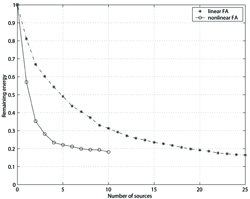Finding needles in haystacks
Cocktail parties and other comparably noisy environments present extreme examples of the challenges inherent to sound separation. Listeners are usually trying to follow a single voice in the midst many other conversations, glasses clinking and music playing. The problem is not unique to humans, however - recognising sounds from mixtures is also a central challenge for machine algorithms that interpret sound. State-of-the-art speech recognition programs, for instance, are typically close to perfect if the speaker is alone in a quiet room, but perform much worse in real-world conditions with other concurrent sound sources. One solution to this problem is to use multiple microphones to record several people speaking simultaneously. The voice of a particular speaker could then be selected based on the independency of the audio signals. In practice, however, the assumption of independent signals holds as a more or less rough approximation, if not at all. Interestingly, prior information on the signal sources – such as the distance between them – can reduce the complexity of the solution and lead to simplified algorithms. The problem then boils down to one question: how to identify accurately which voice signals should be grouped together and which ones can be interpreted individually. With a given cost for different possible outcomes, the so-called Bayesian statistics gave the BLISS project partners the opportunity to make the best decision based on the available information. First, they approximated the dependences between the signal sources by mathematical equations. The resulting models were used to remove or suppress dependences so that the remaining signals became easier to separate. The main disadvantage of the Bayesian methods is their computational complexity, which has in the past limited their application to simple blind separation problems. Still, the proposed approach is not tied to any specific type of signal. Its applications range from the separation of stereo recordings for heading aids, brain waves from medical sensors, and radio signals from telecommunication networks.







